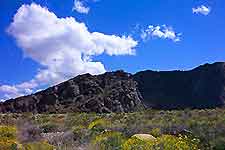Palm Springs History Facts and Timeline
(Palm Springs, California - CA, USA)

When you have a water spring in the desert, it's only natural that people will establish a settlement nearby.
This part of California is a harsh land to live in, so the history of Palm Springs really owes its existence to its proximity to
Los Angeles. The idyllic winter climate and seemingly endless sunshine have been luring vacationers and second-home owners since the 1930s.
Agua Caliente
The Native American Cahuilla tribe was the first group to settle around these natural hot springs, perhaps as early as 500 years ago. It was a tough existence until the Spaniards arrived in the early 19th century. They named the place Agua Caliente and taught the natives to grow squash, beans, corn and other food that could survive in the nutrient-poor soil.
A Desert Oasis
By the late 1800s, the first Americans appeared on the scene, altering the course of history when they renamed the site Palm Springs. The warm, dry climate quickly became a magnet for people in need of this kind of weather for health reasons. Palm Springs enjoys its wonderful microclimate due to its situation between two mountain ranges - the San Bernardino Mountains and the Santa Rosa Mountains.
Hollywood Comes Knocking
Being just a couple of hours' drive from Los Angeles, the village of Palm Springs soon caught the attention of Hollywood actors, producers and other wealthy types in search of quiet seclusion and warm winter weather. Palm Springs was a hugely popular resort from the 1920s onwards, attracting stars like Kirk Douglas, Frank Sinatra, Bob Hope and many other legends who built homes in the area.
Palm Springs also hit the history books as a place where many cutting-edge architects came to experiment with new building styles, including Richard Neutra in 1946. His acclaimed Kaufmann desert house is a modernist classic and still stands today. The 'Desert Modern' style of home became popular, with its style found throughout the American Southwest and Texas today.
Modern Playground
Without tourism there would be no Palm Springs. Its history continues to be written by snowbirds that come to escape the colder climes of their primary residences. Often touted as the 'Golf Capital of the World', the city now boasts dozens of golf courses, which is something a bane for environmentalists. Of note, the legacy of the Native Americans can be seen in the Agua Caliente Cultural Museum and the Palm Springs Art Museum.
The Palm Springs Aerial Tramway ascends 2.5 miles / 4 km to a mountain top, from where sweeping valley views can be enjoyed. Each year, the city's acclaimed Palm Springs International Film Festival creates a red carpet event, and the more recently established Coachella Music Festival is a major part of the cultural calendar. There are five-star resorts, casinos, a full-service airport and a city center packed with quality restaurants, shops and services, which together keep the millions of annual visitors happy and entertained.
 When you have a water spring in the desert, it's only natural that people will establish a settlement nearby.
When you have a water spring in the desert, it's only natural that people will establish a settlement nearby.